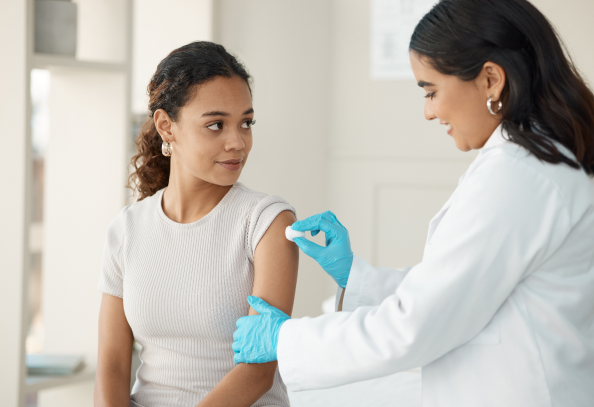
Comment faire pour éviter une infection par l’HPV ?
Protégez-vous et vos proches. Faites connaître la prévention de l’HPV et les avantages des contrôles pour responsabiliser votre entourage et créer un monde plus sûr. Parlez-en à votre médecin ou pharmacien pour plus d’informations sur l’HPV et votre situation personnelle.
Il n’existe aucun traitement contre les infections à l’HPV, mais elles peuvent être en grande partie prévenues grâce à la vaccination.


Le préservatif n’offre pas une protection complète3
Le virus HPV se transmet par contact avec une muqueuse infectée. Concrètement, cela signifie qu’une contamination peut avoir lieu même s’il n’y a pas pénétration.
Le préservatif reste néanmoins un moyen indispensable mais imparfait pour se protéger contre les infections sexuellement transmissibles et une éventuelle grossesse.


Se protéger via la vaccination
Tout comme pour d’autres virus (grippe, hépatite B, etc…), la vaccination est un moyen efficace. De cette manière, même en cas de contact avec le virus HPV, des anticorps le détruiront naturellement et empêcheront l’infection de se propager.
Pour obtenir une efficacité optimale, la personne à vacciner ne devrait pas encore être infectée par le virus. D’où l’intérêt de vacciner à un âge précoce, avant les premiers contacts sexuels.
Comme déjà mentionné précédemment, > 80%¹ de la population sexuellement active sera confrontée à une infection HPV, dont presque 90%³ éliminera spontanément le virus.
Cependant, même si vous avez déjà été atteint d’une infection à l’HPV après un rapport sexuel, la vaccination peut aider à protéger contre tous les autres types d’HPV couverts par le vaccin. N’hésitez pas à envisager la vaccination avec votre médecin ou pharmacien.

Est-ce que ton.ta partenaire est vacciné.e contre l’HPV ?
N’hésite pas à demander à tes partenaires sexuels s’ils sont vaccinés contre l’HPV.
ADN = Acide désoxyribonucléique, une macromolécule biologique qui contient toute l’information génétique
HPV = Papillomavirus Humain
IST = infections sexuellement transmissibles
- Chesson HW et al. The estimated lifetime probability of acquiring human papillomavirus in the US. Sex Transm Dis 2014;11:660-664.
- Shi R et al. BMC Res Notes. 2014;7:544;Factors associated with genital human papillomavirus infection among adult females in the United States, NHANES 2007-2010.
- Conseil Supérieur de la Santé. Vaccination contre les infections causées par le papillomavirus humain. Bruxelles : CSS; 2017. Avis n° 9181.
- https://www.sciensano.be/sites/default/files/hpv_primaire_communication_fr_20241101_sciensano_1.pdf. Last access: 02/2025.
- Hartwig S. et al. Estimation of the overall burden of cancers, precancerous lesions, and genital warts attributable to 9-valent HPV vaccine types in women and men in Europe. Infect Agent Cancer. 2017;12:19 (Annex 1&2).
- Hartwig S. et al. Estimation of the epidemiological burden of HPV-related anogenital cancers, precancerous lesions, and genital warts in women and men in Europe: potential additional benefit of a nine-valent second gene-ration HPV vaccine compared to first generation HPV vaccines. Papillomavirus Res. 2015;1:90–100 (Annex 3).
- IARC report: https://hpvcentre.net/statistics/reports/BEL.pdf?t=1701719033972. Last access: 02/2025.
- ECDC 2020. Guidance on HPV vaccination in EU countries: focus on boys, people living with HIV and 9-valent HPV vaccine introduction (europa.eu). Last access: 02/2025.
- Satterwhite CL et al. Sexually transmitted infections among US women and men: pre-valence and incidence estimates, 2008. Sex Transm Dis 2013;40:187–93.
- Woodman C. et al. The natural history of cervical HPV infection: unresolved issues. Nat Rev Cancer. 2007;7:11–22.
- https://www.vaccination-info.be/la-vaccination-contre-le-papillomavirus-humain-hpv-une-vaccination-pour-tous/. Last access: 02/2025.
- Hartwig S. et al. Estimation of the epidemiological burden of HPV-related anogenital cancers, precancerous lesions, and genital warts in women and men in Europe: potential additional benefit of a nine-valent second generation HPV vaccine compared to first generation HPV vaccines. Papillomavirus Res. 2015;1:90–100.
- INAMI: Variations de pratiques médicales. Rapport Col de l’utérus, conisations. https://www.belgiqueenbonnesante.be/images/INAMI/Rapports/RAPPORT-FR-Col_de_luterus_conisation_Femmes_2023.pdf. Last acccess: 02/2025.
- Tjalma W. AA. et al. If prophylactic HPV vaccination is considered in a woman with CIN2+, what is the value and should it be given before or after the surgical treatment? Eur Journ Obst & Gyn & Reproduct Biology. 2022;98–101.
- Weaver BA. Epidemiology and Natural History of Genital Human Papillomavirus Infection. J Am Osteopath Assoc. 2006;106:S2–8.
- Bruni, Laia et al. “Global and regional estimates of genital human papillomavirus prevalence among men: a systematic review and meta-analysis.” The Lancet. Global health vol. 11,9 (2023): e1345-e1362.

Ce site web est destiné à vous informer sur les papillomavirus humains. Pour plus d’informations, parlez-en avec votre médecin ou pharmacien.
© MSD Belgium SRL
Boulevard du Souverain 25
B-1170 Bruxelles
© Copyright 2025, all rights reserved
BE-NON-02411
Date of last revision: 02/2025

